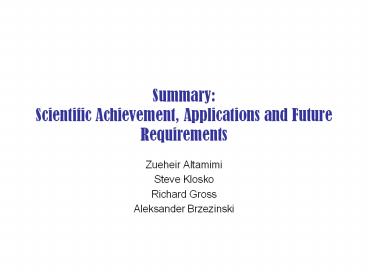Summary: Scientific Achievement, Applications and Future Requirements - PowerPoint PPT Presentation
Title:
Summary: Scientific Achievement, Applications and Future Requirements
Description:
EOP, geocenter, ITRF, station determination -- 5 papers ... Relativity's prediction of the Lense-Thirring precession at the 8-12% level (1-sigma) ... – PowerPoint PPT presentation
Number of Views:23
Avg rating:3.0/5.0
Title: Summary: Scientific Achievement, Applications and Future Requirements
1
Summary Scientific Achievement, Applications
and Future Requirements
- Zueheir Altamimi
- Steve Klosko
- Richard Gross
- Aleksander Brzezinski
2
Session Summaries
- Terrestrial Reference Frame
- EOP, geocenter, ITRF, station determination -- 5
papers - Time Varying Gravity, Gravity Coefficient/Tide
Recovery - SLR determination, use of new mission
capabilities -- 4 papers - k2, k3
- SLR Orbit Determination
- GIOVE-B, LRO, observation corrections, new
software -- 4 papers - Laser Altimetry
- ICESat, Planetary, Mars Volatile Exchange -- 3
papers - Lunar Laser Ranging
- Analysis and constraints on Relativity -- 2
papers - Frame-dragging effects measured by SLR
- Lens Thirring, LARES, Gamma -- 3 papers
3
Reference Frame, Geocenter, Future ITRF
Status ITRF approaching few mm level of
consistency scale problems are being resolved,
SLR important for long EOP history, and new
ITRF2008 upcoming remaining problems --
geocenter in z direction, and achieving sub-mm
goals
4
(No Transcript)
5
Time Varying Gravity
6
Laser Altimetry
ICESat dh/dt
ICESat derived dh/dt shown for 2003-2007 GRACE
derived mass change over same period is very
similar GRACE measures mass change ICESat
measures volume change
7
Topographic Images from MOLA Altimetry
Ice filled crater
Outflow channels
Cratered highlands
660 x 430 km
1800 x 1400 km
1800 x 1000 km
8
Seasonal Mass Changes over 4 Mars Years
------ GCM ------ Best fit to observed changes
8
9
Lunar Laser Ranging (LLR)
38 years of observations Modelling so far at
cm-level Long-term stability (e.g., orbit) ?
Earth-Moon dynamics ? Relativity parameters
?
?
9
10
Retro-Reflectors on the Moon
Apollo 11 July 1969
Apollo 14 Jan./Feb.71
Apollo 15 Jul./Aug.71
X
Luna 17 Nov.70...
Luna 21 Jan.73...
11
Gravity Model Uncertainty and LT Error
LT Results for Recent GRACE gravity models
12
SLR Confirms General Relativity
Satellite laser tracking to LAGEOS-1 and -2
appears to confirm General Relativitys
prediction of the Lense-Thirring precession at
the 8-12 level (1-sigma) This is possible only
with the dramatically improved geopotential
models from the GRACE mission Uncertainties in J4
and J6 (including rates) dominate current error
budget, as expected Improvements in dynamical and
measurement models help make it possible to
achieve a reliable solution with only a few years
of data More years of GRACE data will provide a
more accurate mean field and extend the interval
for a Lense-Thirring test that does not require
mapping zonals back to an earlier epoch
13
(No Transcript)































